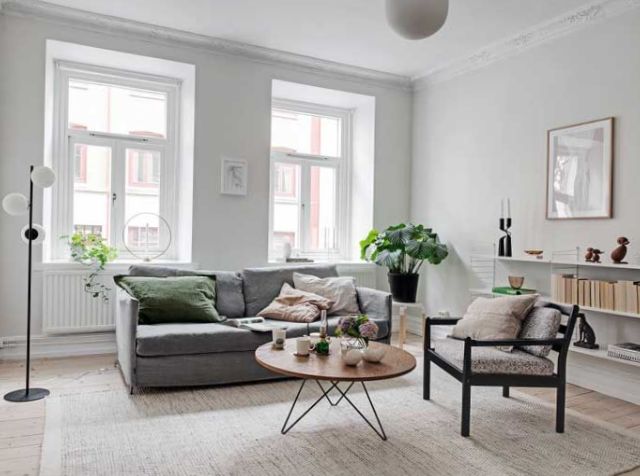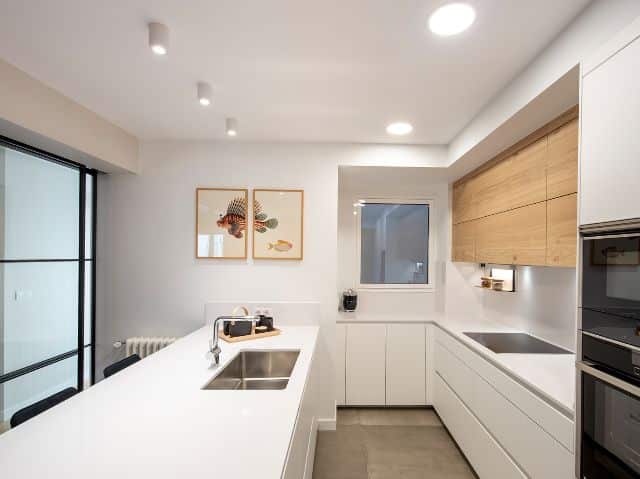The Nordic style was born as a response to the long, dark winters of Scandinavia, where natural light is scarce and becomes an essential resource. For this reason, lighting is not a complement, but the central axis of this design: the aim is for spaces to be bright, warm and cozy, both with natural and artificial light.
Beyond furniture or light colors, the true essence of the style lies in how light transforms the environments, brings spaciousness and transmits serenity. The balance between clarity, natural materials and functionality turns each home into a refuge designed for rest and coexistence.
Table of Contents
Making the most of natural light
One of the fundamental pillars of the Nordic style is to squeeze every ray of sunlight that enters the home. Since natural light is scarce in the regions of origin of this design, every window and every reflection counts.
The layout of spaces is designed with a clear purpose: to let clarity flow unobstructed. Furniture is usually placed in a way that does not block the entry of light and open structures are preferred, where rooms are visually connected.
Colors also play a key role. Walls in white or very light tones function as mirrors that amplify luminosity, while light ceilings and bleached wood floors help maintain visual freshness.
As for textiles, the Nordic style opts for light, translucent curtains in neutral tones. No heavy fabrics or dark colors that dull the space. The idea is to allow the light to filter gently, creating a diaphanous and cozy atmosphere at the same time.
Mirrors are an intelligent resource to enhance this sensation. Placed in front of windows, they double the clarity and provide spaciousness, a very practical solution especially in small homes. In short: natural light is king and Scandinavian design revolves around it.

Enhance clarity with neutral and light tones.
If there is a color that defines the Nordic style, that is white. It is used as a base on walls, ceilings and often also on floors, because it provides a feeling of spaciousness and reflects light optimally. But not everything remains in the coldness of white: the interesting thing is how it is combined with other neutral tones to create a balanced and warm palette.
Beige, soft grays and sand tones complement white, adding depth without breaking the serenity. These shades create an enveloping effect and allow spaces to feel neither flat nor impersonal.
The great ally of this palette is light wood, present in floors, tables, chairs or lamps. The natural warmth of this material offsets the neutrality of the cold tones and reinforces that homey feeling so characteristic of the Nordic style.
In addition, small accents in pastel colors, such as light blue or mint green, can be included in cushions, blankets or decorative accessories. These details add freshness without clashing with the overall ambiance.
The key is to keep it simple: less is more. It is not a matter of cluttering the space with objects, but of carefully choosing each element so that it contributes to enhance clarity and visual harmony.
Lamps with simple lines and natural materials
When natural light is gone, lamps come into play, and this is where the Nordic style unfolds all its charm. The choice of lighting fixtures is fundamental to not break the minimalist essence, but at the same time to achieve warmth.
Nordic style lamps are characterized by their simple lines, without overloaded ornaments. Geometric designs, smooth shades and thin metal structures coexist with warmer materials such as wood and natural fibers. This mix maintains the balance between functionality and aesthetics.
Glass also plays an important role. Lamps with transparent or semi-translucent shades allow light to be diffused in a soft and homogeneous way, avoiding aggressive contrasts.
Recommended products

In Stock, delivery in 24/48h
29.49 £
Haakon Wood and Textile Table Lamp
View product

In Stock, delivery in 15-20 days
22.89 £
Bekasi Metal & Wood Pendant Lamp
View product

In Stock, delivery in 24/48h
13.39 £
Jedali Wall Lamp
View product

In Stock, delivery in 24/48h
22.19 £
Meistter Metal Pendant Lamp
View product
As for the bulbs, it is advisable to opt for those of warm light (around 2700K to 3000K). This yellowish tone generates a feeling of home, of shelter, and contrasts with the coldness of the intense white lights that are usually used in offices.
An interesting detail is to incorporate hanging lamps over the dining table or in specific corners, since in addition to illuminating, they fulfill a decorative function that enhances the personality of the space. In short, light fixtures are key pieces to complete the visual narrative of the Nordic style.
Layers of lighting for a cozy atmosphere
The secret to successful Nordic lighting lies in not relying on a single light source. Instead, “layers” of lighting are built in to modulate the mood according to the occasion.
The first layer is general light, usually provided by a single ceiling lamp or several discrete spotlights. Then there is spot light, which is placed in work or reading areas, such as floor lamps by the sofa or table lamps on the desk. Finally, ambient light adds warmth and is achieved with candles, garlands of lights or auxiliary lamps with translucent shades.
The interesting thing is how these layers combine to create different atmospheres. A family gathering may call for an evenly lit room, while an evening of reading calls for dim, focused light.
The big challenge is to maintain harmony without falling into excess. Nordic style does not allow unnecessary or disproportionate lamps. Each point of light must have a meaning and a function. Thus, the result is a cozy, intimate and perfectly balanced atmosphere.
Lighting in different rooms of the home
The Nordic style is not limited to a single formula; on the contrary, it adapts to each space in the home according to the functional and emotional needs of those who inhabit it. The key is to maintain aesthetic coherence while adjusting the lighting to each environment.
In the living room, considered the heart of the home, light should promote comfort and conviviality. A simple ceiling lamp can provide the general lighting base, while floor lamps next to the sofa or over a side table add warmth and functionality. Strategically placed candles reinforce the cozy ambiance, ideal for gatherings or quiet evenings.
The bedroom calls for something different: here serenity prevails. The lighting becomes softer, with table lamps on the bedside tables or indirect lights that create a relaxing environment. Avoiding overly bright lights is essential to maintain a restful atmosphere. In addition, including garlands or small lamps with warm light can add an intimate and personal touch.
In the kitchen and dining room, functionality is combined with aesthetics. Pendant lamps over the dining table are a Nordic classic: they add character, concentrate light where it is needed and, at the same time, decorate. In the kitchen, spot lighting is key: LED strips under furniture or recessed spotlights ensure good visibility without breaking the minimalist line.

In each room, the idea is the same: to balance practicality and warmth, always respecting the prominence of light as a central element of Scandinavian design.
Nordic lighting: final keys
Lighting with Nordic style is much more than choosing beautiful lamps: it is building an atmosphere where natural and artificial light complement each other to generate harmony, serenity and warmth. Every detail counts, from the orientation of the furniture to the shade of the bulbs.
The secret lies in respecting three principles: making the most of natural light, adding simple luminaires made of noble materials and working with layers of lighting that provide flexibility and comfort. With these fundamentals, any space can be transformed into a cozy, functional and lively refuge, true to the spirit of Scandinavian design.


